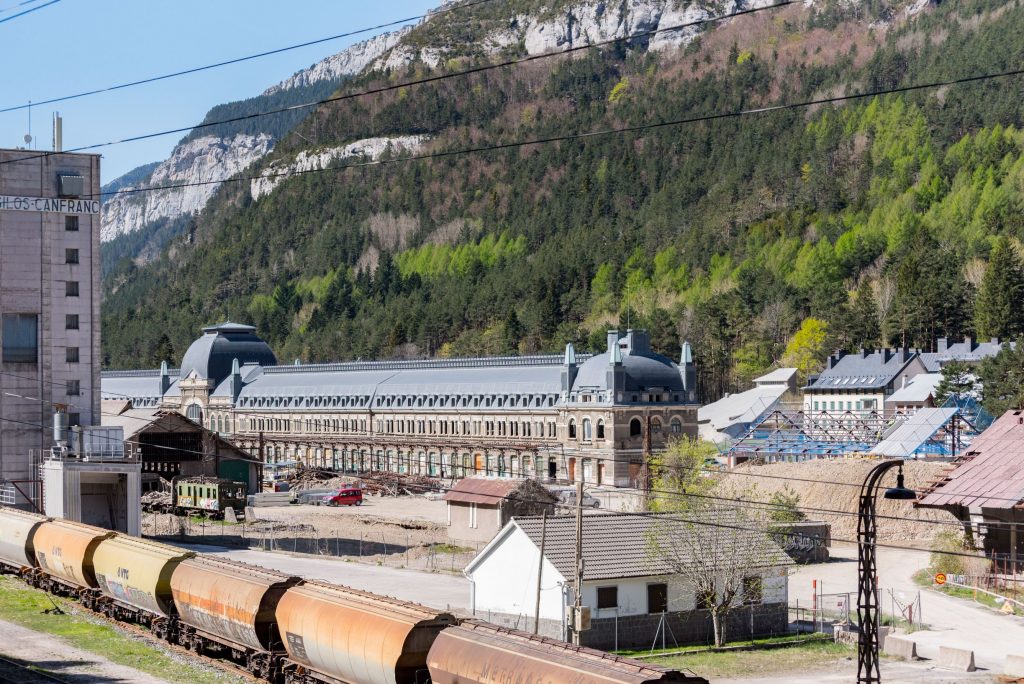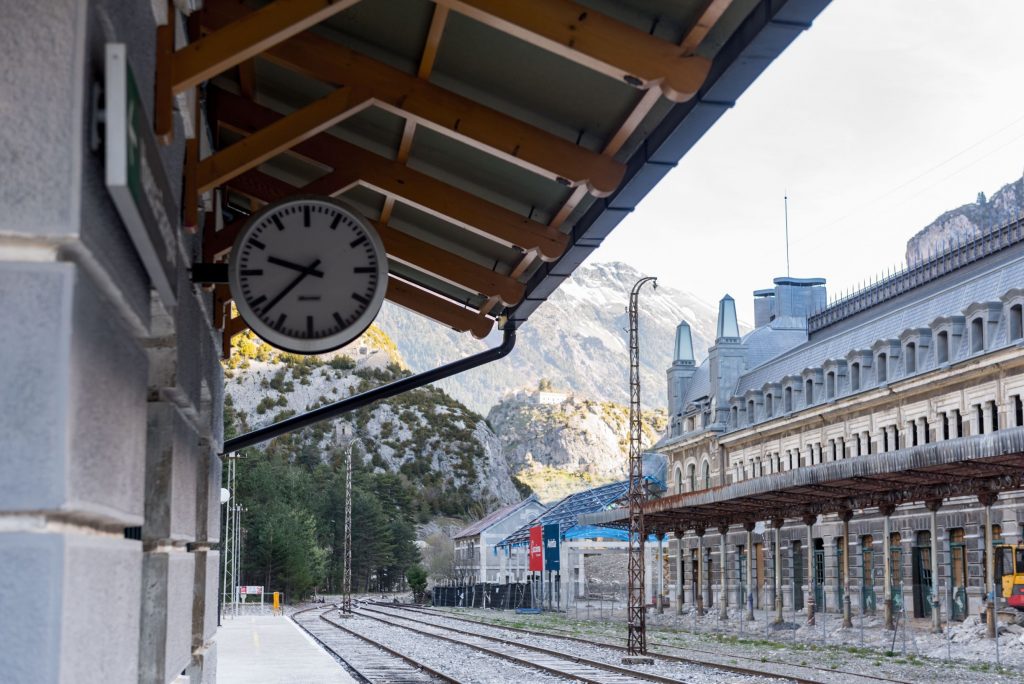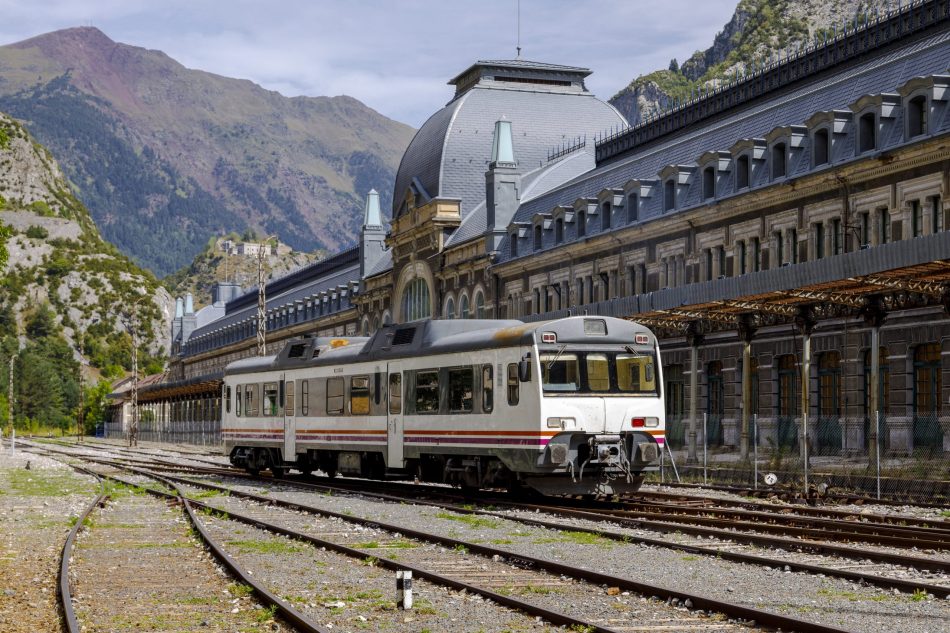Although the refurbishment work on Canfranc station is nearing completion, it is still astonishing in its architectural style and size. Apart from the fact that sensitive souls can pick up a somewhat haunted atmosphere, nothing hints at the station’s past. It was the setting for the transport of gold stolen by the Nazis, international espionage and the flight of hundreds of Jews during the Second World War.
Anyone approaching the station for the first time will undoubtedly wonder why the disproportionate building is located in this abandoned location.
At the end of the nineteenth century, the small village of Canfranc was chosen by the Spanish and French governments as a location for international transport of goods and passengers between Zaragoza in Spain and Toulouse and Bordeaux in France. The border station would be checked by both Spanish and French customs.
Build
The construction of the station was difficult due to its size and remote location. The foundation stone was laid in 1915 and ten years later – after the First World War – construction completed. In July 1928, King Alfonso XIII, General Primo de Rivera and French Prime Minister Paul Painlevé opened the impressive station.
The 1930s saw Canfranc station buzzing with activity and an international flow of passengers and goods. However, the flourishing commerce near the small village came to an abrupt end when the Spanish Civil War broke out. The station closed for several years to prevent an invasion from France.
Modernist and industrial

The modernist, narrow but 240 meters long building is divided into three parts. In the central part were the counters resembling huge wooden confessionals. In each room, large stained glass windows combined with classical pillars and dark woodwork. With three hundred windows, 156 doors, a slate roof, reinforced concrete walls, numerous columns and other modernist Spanish and French elements, the station certainly fulfilled its objective of being representative of the century just ushered in.
The industrial character of the building, attained through extensive use of glass, iron and concrete, is characteristic of the architecture of that time. Outside the main building, the station had various loading and unloading areas for the transhipment of goods and the storage of machines.
Important find
One afternoon in October 2000, French bus driver and guide, Jonathan Díaz, born of Spanish parents, found old documents mentioning “gold bars” in an abandoned shed on the grounds of Canfranc station. He did not find this too strange because he had heard about this many times from his older fellow villagers.
Díaz began studying the papers and found out about the Germans’ gold shipments. With his findings, he travelled to Zaragoza for help from the authorities, but got no response. Once aware of Díaz’s find, the Spanish railway company Renfe collected 24 more mailbags full of documents from the 1930s, 40s, 50s and 60s. There began frantic efforts to recover the French finder’s loaded papers.
Nazi gold transport
The papers found by Díaz released hitherto “forgotten” information about the Nazis’ dealings on Canfranc during World War II. At that time it was under the supervision of the German SS and Gestapo. The so-called neutrality of Spain during WWII provided the Germans with a perfect cover for the transport of gold and goods stolen from Jews.
The documents show there were 86.6 tons of gold, 4 tons of silver, 10 tons of watches, 44 tons of weapons material and 4 tons of opium. The stolen goods were transported in Swiss trains from Germany to Spain and Portugal. Parts of the precious metal were then loaded onto ships in Lisbon on their way to South America. Towards the end of the war, some Germans also followed this gold route to countries on the South American continent.
Tungsten
Spain was not at war with the Third Reich, but built up debt by accepting aid during the civil war. This debt was paid off with tungsten metal mined in Galician mines. The Germans armoured their tanks and cannons with this mineral. The Germans paid for the rest with at least 12 tons of gold and 4 tons of opium, according to data found by Díaz.
Flight of the Jews
Before and during the Second World War, international customs at Canfranc also provided a gateway to freedom for Jews fleeing from the Germans. Official data shows around 13,000 Jews crossed the Spanish border via the three border crossings at the time: Port Bou, Canfranc and Hendaya.
The memoirs of Antonio Galtier Rimbaud, customs officer at Canfranc between 1935 and 1946 – show thousands of Jews fled via Canfranc station towards North Africa and South America. Or they had Spain and Portugal as their final destination.
According to Rimbaud, the scenes which took place at the station were heart breaking. Many families crossed Europe to save their lives, only to arrive in ‘safe’ Spain and be sent back by the Gestapo. Some were captured and others fled. Those who did manage to get into the main hall still had to get a ticket to a safe destination. If that didn’t work, these people were sent back by the Germans or worse.
The great decay
After the end of the Second World War, activities at the station stopped until 1949. Even though international transport took place via Canfranc again, it never returned to the level of the 1930s. In January 1970, a train crashed off the French railway bridge. Since then, the French government has refused to restore the bridge. This leaves the last part of the route to Canfranc broken up and Canfranc an end-of-the-line station. Repeated and urgent requests from the Spanish government to restore the bridge were unsuccessful.
Due to the small importance of the village of Canfranc itself, there were soon only two trains a day. The station building fell into disrepair. And despite being declared a Historic-Artistic Monument by the government of Aragon, it was chronically ignored by those same authorities. The consequence of this, partly thanks to the severe mountain climate, is easy to guess. The building, which is not even a century old, was seriously damaged on all sides.
New life as a hotel

In 2005, the Spanish government signed an agreement for a major project. A luxury hotel and a large shopping centre were to breathe new life into the old station building. Due to a lack of money, the project stopped after a while. At the end of March 2012, new plans for the station and the surrounding area were presented.
In December of that year, the Spanish Ministry of Development sold Canfranc station to the regional government of Aragon for a symbolic sum. The latest plan is in progress. It includes more trains running through the station, turning the building into a luxury hotel and connecting the site with the ski resorts of Astún, Candanchú and Formigal by means of a cable car.


